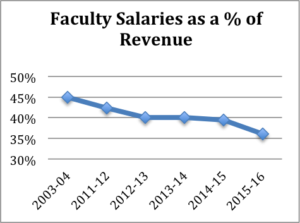by Maya Bendotoff and Karl Ewald

CCFT recently commenced negotiations with the District on salary and benefits, safety, the DC matrix, and some other issues. Negotiations have been moved to Human Resources (from Administrative Services). For our first two negotiations meetings, Feb. 23rd and Mar. 2nd, took place in the transition period to Human Resources. Angela Hoyt joined Cabrillo as the new Director of Human Resources in early March and will be the district’s chief negotiator. We have a tight schedule for the rest of the year. If all goes quickly, we will have a proposal out for ratification in May. If not, we will likely have to wait until the start of the fall semester to ratify any proposed agreement.
CCFT continues to push for the Governing Board to prioritize faculty salaries. We believe that the starting point for full-time faculty salaries should be in the top third in the state. The District has agreed to the principle of improving faculty salaries. In addition, Section 13.1 of our Contract states that, “The intent is that CCFT receive a fair share of increased revenues to be allocated toward the faculty total compensation package of salary and benefits, with the goal of returning to and improving the salary schedules as quickly as possible.” The Contract language goes on to list various information that will be assessed in doing so, with a goal of increasing the percentage of the college budget spent on faculty salaries as a percentage of the budget.”
Below is some information that we recently compiled for the District negotiations team and Governing Board. About fifteen of your Council representatives attended public comments prior to the closed session of the April 3 Governing Board meeting to support Karl Ewald’s summary comments in regards to our budget analysis, which included the following the information.
Spending on faculty salaries as a percentage of college revenue
Current trends show that the college remains on a trend of decreasing the spending on faculty salaries as a percentage of total revenue. The percentage of base budget revenue going to faculty salaries decreased from 44.89% in 2003-04 to 39.98% in 2014-15 to 36.08% in 2015-16 (this includes both adjunct and full-time faculty).
Note that this is true for 2015-16, even though the state budget included about $570,000 in funding specifically to increase full-time faculty positions.
Source: Salaries Shown By Bargaining Group (provided to CCFT in negotiations)
Net Ending Balance (NEB)
At the same time, the net ending balance (NEB) for the base budget increased from 10% of total revenue in 2003-04 to 28% of total revenue in 2015-16. For the total budget the NEB increased from 9% of total revenue in 2003-04 to 23% of total revenue in 2015-16. Note that college did receive a significant amount of one-time funds from the state over the past couple of years.
The following graph shows the budgeted NEB versus the actual NEB for the restricted and unrestricted general fund (fund 10):
Source: CCFS 311 Budget Report to the State
Retiree Benefits Fund
Over this period, starting in 2006-07, the District created a retiree benefits fund (fund 23). The amount in this fund significantly surpasses goals set by a task force several years ago.
For 2015-16 the District allocated an additional $3.5 million to this fund (note that faculty reps on the College Planning Council expressed concern with this.) The 2016-17 budget shows an increase to $8.2 million. Note that this fund is separate from, and in addition to the net ending balance. According to the 2016-17 Final Budget, “the current available fund balance in the Retiree Fund of $7,647,539, is 35.16% of the total projected liability ($7,647,539/$21,751,627).”
Retiree Benefit Fund
Year Amount in Retiree Benefit Fund
2008-09 1.4 million
2014-15 3.8 million
2015-2016 7.6 million
Source: Cabrillo College Final Budgets: 2006-07 through 2016-17
Statewide Salary Data
Cabrillo faculty salaries have fallen precipitously in the last decade compared to other colleges in the state. Most of this drop took place at the start of the last recession when the college created a large FTES reserve.
The following chart shows the trend in Cabrillo’s salaries in comparison to other colleges in the state. Note that the basic aid districts, which generally place near the top of such studies, have been removed (with basic aid districts removed Cabrillo appears higher than it would otherwise).
Summary
CCFT acknowledges and appreciates the effort to make salary improvements over the past couple of years. While we have made modest gains, faculty salaries remain low statewide and as a percentage of the college budget. This is true although the state budget has included specific funding to increase the number of full-time faculty. Faculty, and all college employees, also must contend with the fact that we live in one of the most expensive areas in the country.
Cabrillo has an above average net ending balance, has funded over a third of all future retiree benefits obligations in a separate fund, increased the official reserves from 5% to 7%, and still has a large amount of one-time funds for the current year. We believe this provides a sound financial context to make progress on improving faculty salaries for 2017-18 and beyond.
You can view a complete version of the information we shared with the Governing Board online here.



